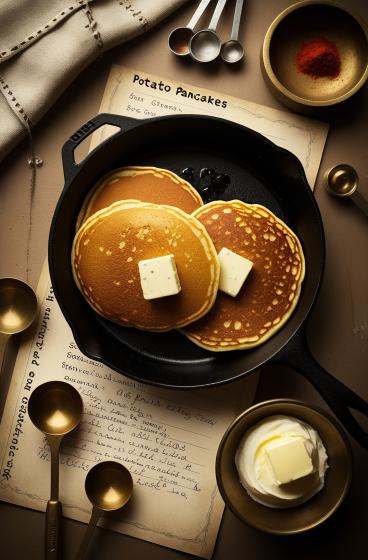Back in Berlin, in a corner café that didn’t even have a sign, I had my first real Kartoffelpuffer. It was winter. Cold air, clinking beer steins, kids with runny noses laughing near the heater. And this plate… this hot, crisp-edged, soft-centered wonder that tasted like my grandma had been reborn in a frying pan. I didn’t speak much German, but I knew I’d found something sacred.
Let me tell you, German potato pancakes ain’t just food. They’re childhood. They’re Sundays at the market. They’re grated fingers and secret family wars over how fine to shred. Every region in Germany does it a little different. But one thing’s universal — the sizzle in the pan and that magical moment when starch, fat, and heat turn simple potatoes into gold.
This recipe isn’t the fast-food knockoff. No shortcuts. No dry pancakes pretending to be crunchy. This here’s the real deal — properly seasoned, fried in shimmering oil, crispy outside, tender and onion-sweet inside. With applesauce, sour cream, or just straight off the plate? That’s up to you.
What Makes German Potato Pancakes So Dang Special?
Authentic German potato pancakes, or Kartoffelpuffer, are grater-happy miracles made with raw potatoes, onions, eggs, and flour or starch. Not mashed. Not precooked. Raw. You shred ‘em, squeeze the life out of ‘em, mix in your basics, and fry ‘em till the edges get those crunchy, lacy little bites that make your teeth dance.
These aren’t soft like hashbrowns or mushy like American latkes (no offense). They’re thin and lacy and loud when you bite in. Germans serve them sweet or savory — yes, sweet. Don’t knock applesauce on a hot pancake till you try it. And they’re sold on every street market from Cologne to Munich like hotcakes… because they are hotcakes.
Also — and this is critical — the potato starch that settles in the bottom of your bowl after squeezing? Don’t you dare throw that out. That’s pure magic. We’ll use it.
Ingredients & Smart Substitutions
Fresh ingredients matter here. Skip the pre-shredded nonsense unless you want sadness on a plate. Russets or Yukon Golds are your heroes. Onions must be sharp and fresh — nothing mushy or sprouting green tops.
Here’s your lineup:
| Ingredient | Amount | Notes & Substitutions |
|---|---|---|
| Potatoes (Russet) | 2 lbs (900g) | High-starch types like Russet or Yukon Gold. Waxy potatoes won’t crisp. |
| Onion | 1 medium | White or yellow. Red’s too sweet, too watery. |
| Eggs | 2 large | Bind everything. Can sub with flax eggs (1 tbsp flax + 2.5 tbsp water per egg). |
| All-purpose flour | ¼ cup (30g) | Can sub with matzo meal or potato starch (for gluten-free version). |
| Salt | 1½ tsp | Don’t skimp. Potatoes drink it up. |
| Black pepper | ½ tsp | Fresh cracked if you got it. Optional dash of nutmeg = chef’s kiss. |
| Neutral oil (canola or sunflower) | For frying | Don’t use olive oil — burns too quick and flavors too strong. |
Optional Add-Ins
- Fresh parsley or chives: A tablespoon or two for color and brightness.
- Garlic: A clove minced into the batter, but don’t go heavy.
- Carrots or zucchini: Grated and squeezed — sneaky veggies, great for kids.
Step-by-Step Instructions: Getting That Crisp Right
Alright, aprons on. Grater ready. Get your elbow into it.
Step 1: Grate the Potatoes & Onion
Grate ‘em fine. Like, really fine. The bigger the shred, the less cohesive the pancake. You want the potatoes to cling to each other like clingy lovers.
Pro tip: grate the onion with the potatoes. Helps prevent oxidation (aka ugly brown goop). Plus, less tears if you move quick.
Step 2: Squeeze Like You Mean It
Take that potato-onion mixture and squeeze the heck out of it using a cheesecloth, clean dish towel, or strong hands. Like, get violent. We need those bad boys dry.
Catch the liquid in a bowl. Let it sit for a minute. See that white stuff settling at the bottom? That’s potato starch — don’t toss it. Pour off the liquid but keep that starch. Scrape it into your batter. That’s what helps give the pancake its structure.
Step 3: Mix the Batter
Dump the dry potato mix into a bowl. Add the eggs, flour, salt, pepper, and the reclaimed potato starch. Stir it up with a fork. Batter should be thick, spoonable, and moist but not soggy. If it’s too wet, add a bit more flour. Too dry? Crack in another egg.
Optional herbs or extras go in now.
Step 4: Heat Your Oil — Don’t Rush It
Get a heavy pan. Cast iron is your best friend here, non-stick works in a pinch. Pour in enough oil to shallow-fry — about ¼ inch deep. Heat it till it shimmers. Not pops. Shimmers.
Drop a tiny bit of batter in. If it bubbles up instantly, you’re good to go.
Step 5: Fry Time
Spoon in about 2 tablespoons of batter per pancake. Flatten gently with a spatula. Don’t smash it like a burger, just a soft nudge. Fry 3–4 at a time so the pan doesn’t cool down.
Let them go undisturbed for 3–4 minutes per side. Don’t peek too soon. You want deep golden edges, the kind that make a little “crk-crk” when they’re done.
Step 6: Drain and Serve Hot
Remove to a wire rack or paper towel-lined plate. Salt lightly while hot. Serve immediately — these pancakes don’t wait for anyone.
Cooking Techniques & Potato Science
Why raw grated potatoes? Because that’s what makes these pancakes light and crisp and slightly chewy, all in one bite. Pre-cooked mash just gets doughy.
The starch in potatoes behaves like glue when cooked. That’s why we save that starch from the squeezing step — it’s natural binding magic. No weird powders needed.
Using flour gives structure, but too much makes them tough. Eggs help hold it all together while adding richness. But again, moderation. You don’t want potato omelets.
Frying in shallow, hot oil crisps the outside while steaming the inside. If the oil’s not hot enough, the pancakes absorb it like a sponge. Gross. Always test your oil with a drop of batter first.
Tools That Make a Difference
- Box grater or food processor: You’ll need muscle or speed.
- Cheesecloth/dish towel: For squeezing — a must.
- Cast iron skillet: Holds heat evenly. Crisps like a dream.
- Slotted spatula: To flip without breaking your pancake soul.
Storage & Reheating
Let ‘em cool completely before storing. Stack with parchment between layers.
Store: In fridge, 3 days max.
Freeze: Lay flat on a tray, then transfer to bags.
Reheat: Oven at 375°F (190°C), 8–10 minutes. No microwave — unless you like soggy sadness.
Substitutions & Variations
- Vegan: Use flax eggs, skip egg entirely with extra starch and a spoon of aquafaba.
- Gluten-Free: Sub flour with potato starch or rice flour.
- Spicy: Add cayenne, chopped chili, or pepper flakes.
- Sweet: Skip onion, add 1 tbsp sugar and a pinch of cinnamon. Serve with applesauce or fruit compote.
Serving & Pairing Suggestions
Traditionally, Germans eat Kartoffelpuffer with applesauce. Warm or cold — that contrast with the hot, salty pancake is dreamy. Sounds odd? Trust it. It’s culinary yin and yang.
But also — sour cream with chives, smoked salmon, even a soft-poached egg on top if you’re feeling brunchy.
For heartier meals, serve alongside:
- German sausages (bratwurst, knackwurst)
- Sauerkraut or red cabbage
- Green salad with mustard vinaigrette
- A crisp pilsner or dry Riesling
Presentation-wise, stack ’em high. Drizzle with herbs. Let the crispy edges stick out like they’re showing off. They earned it.
When’s the Best Time to Eat These?
Right out of the pan.
No really — the second they come out. That’s when they shine brightest.
In Germany, they’re eaten at Christmas markets, autumn fairs, even roadside stands. Breakfast? Absolutely. Lunch? Ideal. Dinner? With a salad and sausage? Yes please. Midnight snack? Dangerous but delightful.
Final Thoughts: Keep It Crispy, Keep It Real
The best German potato pancakes aren’t fussy. They’re honest. They come from basic, humble ingredients turned into something golden and joyful with just a little technique.
What makes this recipe shine? The grated onion that melts into the batter. The saved potato starch that keeps things together without heaviness. And the patience not to flip too early. That’s where the magic lives.
Troubleshooting tip: if they fall apart, your batter’s too wet. If they’re greasy, oil wasn’t hot enough. If they’re chewy, you overmixed. But hey — even the “failures” taste pretty darn good dunked in applesauce.
Go on. Grate, squeeze, fry, crunch. The good stuff’s just a pan away.
FAQs
1. Can I make these ahead of time?
You can, but they’re never quite the same. If you must, reheat in a hot oven to bring back the crunch.
2. What kind of potato is best?
High-starch varieties like Russet or Yukon Gold. Avoid waxy potatoes — they get gummy.
3. How do I keep them from turning gray?
Grate the onion with the potato — its natural sulfur slows oxidation. Also work fast and keep the mix covered.
4. Is applesauce really the best topping?
It’s classic. Sweet against salty crispness is unbeatable. But sour cream, salmon, or even chili oil work too.
5. Can I bake these instead of frying?
You can, but they won’t crisp properly. If you must, brush generously with oil and bake at 425°F, flipping halfway.
Want golden perfection on your plate? Start with spuds. And trust the old-school German grannies — they knew what they were doing.

